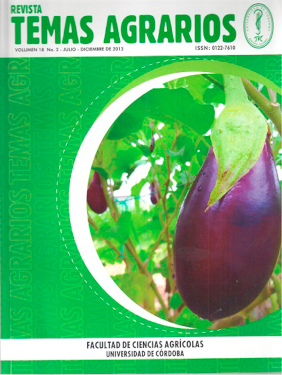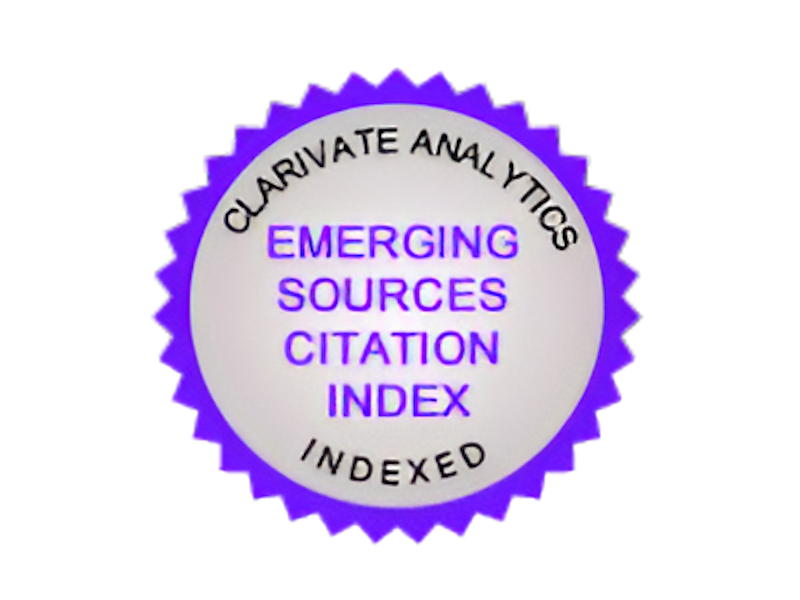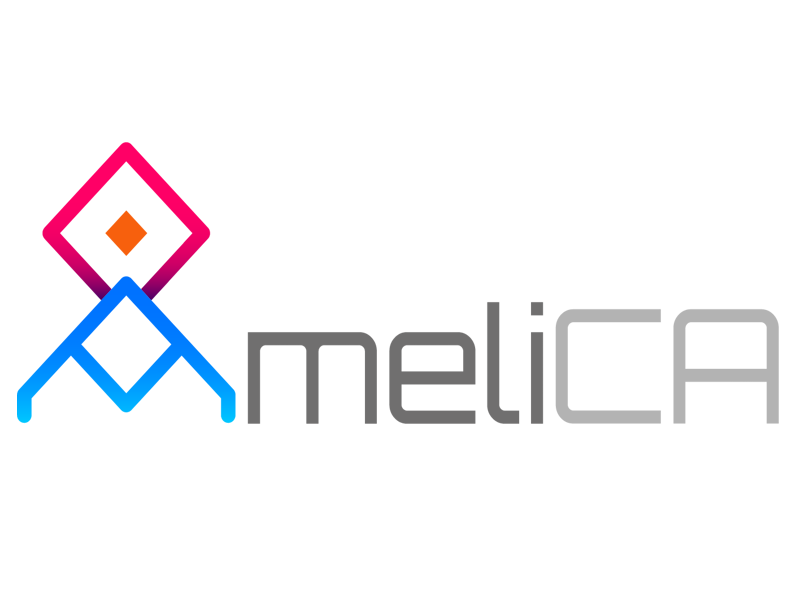Toxicidad de nanopartículas inorgánicas sobre los microorganismos del suelo con importancia agrícola. una revisión
Toxicity of inorganic nanoparticles on soil microorganisms with agricultural importance. a review
Cómo citar
Palencia, S., Combatt Caballero, E., & Palencia, M. (2013). Toxicidad de nanopartículas inorgánicas sobre los microorganismos del suelo con importancia agrícola. una revisión. Temas Agrarios, 18(2), 106-122. https://doi.org/10.21897/rta.v18i2.720
Dimensions
Licencia

Esta obra está bajo una licencia internacional Creative Commons Atribución-NoComercial 4.0.
Mostrar biografía de los autores
Visitas del artículo 896 | Visitas PDF
Descargas
Los datos de descarga todavía no están disponibles.
- An, H. and Jin, B. 2012. Prospects of nanoparticle–DNA binding and its implications in medical biotechnology, Biotechnology Advances; 30:1721-1732
- Bang, S., Lee, T., Lee, S., Kim, P. and Kim, J. 2011. Toxicity assessment of titanium (IV) oxide nanoparticles using Daphnia magna (Water Flea), Environmental health and toxicology; 26:c2011002
- Bardhan, M., Mandal, G. y Ganguly, T. 2009. Steady state, time resolved, and circular dichroism spectroscopic studies to reveal the nature of interactions of zinc oxide nanoparticles with transport protein bovine serum albumin and to monitor the possible protein conformational changes. Journal of Applied Physic; 106:034701
- Barrere, R., D´Onofrio, M., Matas, L. y Marcotrigiao, G. 2011. La Nanotecnología en Iberoamérica, situación actual y tendencias. Observatorio Iberoamericano de Ciencia, Tecnología e Innovación del Centro de Altos Estudios Universitarios de la OEI
- Basu, S., Jana, S., Pande, S. y Pal, T. 2008. Interaction of DNA bases with silver nanoparticles: Assembly quantified through SPRS and SERS. Journal of Colloid and Interface Science; 321:288- 293
- Chatterjee, T., Chakraborti, S., Joshi, P., Singh, S., Gupta, V. y Chakrabarti P. 2010. The effect of zinc oxide nanoparticles on the structure of the periplasmic domain of the Vibrio cholerae ToxR protein. Febs Journal; 277:4184-4194
- Cho, E., Zhang, Q. y Xia, Y. 2011. The effect of sedimentation and diffusion on cellular uptake of gold nanoparticles. Nat Nano; 6:385-391
- Dawson, K., Salvati, A. y Lynch, I. 2009. Nanotoxicology: Nanoparticles reconstruct lipids. Nat Nano; 4:84-85
- Devlin, T. 2004. BIOQUÍMICA: APLICACIONES CLÍNICAS. Cuarta edición. Reverte S. A. USA
- Ezanka, P. Záruba, K. y Král V. 2011. Supramolecular chirality of cysteine modified silver nanoparticles. Colloids and surface A: Physicochemical and Engineering Aspects, 374:77-83
- Fang, J., Shan, X., Wen, B., Lin, J. y Owens, G. 2009. Stability of titania nanoparticles in soil suspensions and transport in saturated homogeneous soil columns, Environmental Pollution; 157:1101-1109
- Frejo, M. T., Díaz, M. J., Lobo, M., García, J. y Capó, M. 2011. Nanotoxicología ambiental: retos actuales, Medicina Balear; 26: 36-46
- Gondikas, A., Morris, A., Reinsch, B., Marinakos, S., Lowry, G. y HsuKim, H. 2012. Cysteine-Induced Modifications of Zero-valent Silver Nanomaterials: Implications for Particle Surface Chemistry, Aggregation, Dissolution, and Silver Speciation. Environmental Science & Techonology; 46(13):7037–7045
- Gheshlaghi, Z., Riazi, G., Ahmadian, S., Ghafari, M. y Mahinpour, R. 2008. Toxicity and interaction of titanium dioxide nanoparticles with microtubule protein. Acta Biochimical Biophysical Sin (Shangai); (40):777-782
- Glibitskiy, G., Jelali, V., Semenov, M., Roshal, A., Glibitskiy, D. and Yu O. 2012. Interaction of DNA with silver nanoparticles. Ukranian Journal of Physic; 57( 7):695-699
- Gojova, A., Guo, B., Kota, R., Rutledge, J., Kennedy, I. and Barakat, A. 2007. Induction of inflammation in vascular endothelial cells by metal oxide nanoparticles: Effect of particle composition. Environmental Health Perspective; 115:403-409
- Gutarowska, B., Skora, J., Zduniak, K. and Rembisz, D. 2012. Analysis of the sensitivity of microorganisms contaminating museums and archives to silver nanoparticles. Int. Biodeterior. Biodegrad; 68: 7-17
- Handy, R., Von der Kammer, F., Lead, J., Hassellov, M., Owen, R. and Crane, M. 2008. The ecotoxicology and chemistry of manufactured nanoparticles. Ecotoxicology; 17: 287-314
- Herzog, E., Byrne, H., Davoren, M., Casey, A., Duschl, A. and Oostingh, G. 2009. Dispersion medium modulates oxidative stress response of human lung epithelial cells upon exposure to carbon nanomaterial samples. Toxicology Applied Pharmacology; 236:276-281
- Hullmann, A. 2006. The economic development of nanotechnology - An indicator based analysis, European Commission, Unit "Nano S&T - Convergent Science and Technologies, Alemania.
- IUPAC.1995.Recommended terminology for the description of carbon as a solid. PAC, 1995, 67, 473. http://goldbook.iupac. org/G02684.html
- Jiang, G., Shen, Z., Bao, Y., Chen, J. and He, T. 2011. Toxicological assessment of TiO2 nanoparticles by recombinant Escherichia coli bacteria. J. Environemtal monitoring; 13:42-28
- Ju-Nam, Y. and Lead, R. 2008. Manufactured nanoparticles: An overview of their chemistry, interactions and potential environmental implications. Science of the total environment; 396-414
- Kopac, T., Bozgeyik, K. and Yener, J. 2008. Effect of pH and temperature on the adsorption of bovine serum albumin onto titanium dioxide. Colloids Surface A Physicochemical Engineering Aspects; 322:19-28
- Lacerda, S.; Park, J., Meuse, C., Pristinski, D., Becker, M., Karim, A. and Douglas J. 2009. Interaction of Gold Nanoparticles with Common Human Blood Proteins. ACS Nano; 4:365-379
- Levard, C., Matt, E., Lowry, G. and Brown, G. 2012. Environmental Transformations of Silver Nanoparticles: Impact on Stability and Toxicity. Environmetanl Science & Technology; 46: : 6900- 6914
- Lin, J., Zhang, H., Chen, Z. and Zheng, Y. 2010. Penetration of Lipid Membranes by Gold Nanoparticles: Insights into Cellular Uptake, Cytotoxicity, and Their Relationship. ACS Nano; 4(9):5421-5429
- Lundqvist, M., Sethson, I. and Jonsson, B. 2004. Protein Adsorption onto Silica Nanoparticles. Conformational Changes Depend on the Particles’ Curvature and the Protein Stability. Langmuir; 20:10639-10647
- Mansoob, M., Kalathil, S., Lee, J. and Hwan, M. 2012. Synthesis of Cysteine Capped Silver Nanoparticles by Electrochemically Active Biofilm and their Antibacterial Activities. Bulletin Korean Chemical Society 22:2592-2596.
- Maynard, A. and Warheit, M. 2011. The New Toxicology of Sophisticated Materials: Nanotoxicology and Beyond, Toxicological Sciences; 120: 109–129
- Mohanraj V. and Chen Y. 2006. Nanoparticles- A review, Tropical Journal of Pharmaceutical Research; 59: 561-573
- Molins, R. 2008. Oportunidades y amenazas de la nanotecnología para la salud, los alimentos, la agricultura y el ambiente, Comunica-Perspectivas, Innovación y Tecnología; 38-53.
- Moore, M. 2006. Do nanoparticles present ecotoxicological risks for the health of the aquatic environment?. Environment International; 32: 967-976
- Mukherjee, S., Menegazzo, N., Brooksh, K., Dhurjati, P., Smorodin, V. y Nohe, A. 2012. Synthesis of L-Cysteine Stabilized Silver Nanoparticles and Their Effects on Cell Viability. Advanced Science Letters; 6:26-33
- Nowacs, B. 2009. The behavoior and effects of nanoparticles in the environment. Environmental pollution; 1 (57):1063- 1064
- Oberdörster, G., Sharp, Z., Atudorei, V., Elder, A., Gelein, R., Kreyling, W. and Cox C. 2004. Translocation of Inhaled Ultrafine Particles to the Brain. Inhalation Toxicology; 16:437-445
- OMS y FAO. 2011. Informe Reunión conjunta FAO/OMS de expertos acerca de la aplicación de la nanotecnología en los sectores alimentario y agropecuario: posibles consecuencias para la inocuidad de los alimentos. Roma
- Park, S., Lee, S., Lee, J., Sim, S., Gu, M., Yi J. and Lee, J. 2012. Toxic effects of titanium dioxide nanoparticles on microbial activity and metabolic flux, Biotechnology and bioprocess engineering; 17:276-282
- Railsback, J., Singh, A., Pearce, R., McKnight, T., Collazo, R., Sitar, Z., Yingling, Y. and Melechko, A. 2012. Weakly Charged Cationic Nanoparticles Induce DNA Bending and Strand Separation. Advanced Materials; 24:4261-4265
- Roiter, Y., Ornatska, M., Rammohan, A, Balakrishnan, J., Hein, D. and Minko, S. 2008. Interaction of Nanoparticles with Lipid Membrane. Nanoletters 8 (3) 941-944.
- Sánchez, J., Guerrero, H., Marín, S., Tamayo, R. y Cosme, M. 2006. Nano: nanotecnología en España, Comunidad de Madrid
- Santhosh, P., Penic, S., Genova, J., Iglic, A., Kralj-Iglic, V. and Ulrih, N. 2012. A study on the interaction of nanoparticles with lipid membranes and their influence on membrane fluidity. Journal of Physics. Conference series 2012; (398): 012034
- Saptarshi, S., Duschl, A. and Lopata, A. 2013. Interaction of nanoparticles with proteins: relation to bio-reactivity of the nanoparticle. Journal of Nanobiotechnology; 11(26): 1-12
- Scientific committee on emerging and newly identified health risks (SCENIHR). 2006. The appropriateness of existing methodologies to assess the potential risks associated with engineered and adventitious products of nanotechnologies. European Commission for Health and Consumer, Bruselas
- Shah, V. and Belozerova, I. 2009. Influence of Metal Nanoparticles on the Soil Microbial Community and Germination of Lettuce Seeds. Water air pollunt. 197:143-148
- Shang, W., Nuffer, J., Dordick, J. and Siegel, R. 2007. Unfolding of Ribonuclease A on Silica Nanoparticle Surfaces. Nano Letter; 7:1991-1995
- Shanzhou, H., Peng, Liu. and Yu H. 2014. Aggregation of Gold Nanoparticles and DNA Damage by Atomic Force Microscopy, Journal of Wuhan University of Technology-Material Science Education; 29(1):180-184
- Shi-Qiang, L., Hong, Z., Rong-Rong, Z., XiaoYu, S., Si-De, Y. and Shi-Long, W. 2008. Impact and mechanism of TiO2 nanoparticles on DNA synthesis in vitro. Science in China Series B: Chemistry; 51:367-372
- Skebo, J., Grabinski, C., Schrand, A., Schlager, J. and Hussain, S. 2007. Assessment of metal nanoparticle agglomeration, uptake, and interaction using high-illuminating system. International Journal of Toxicology;26:135-141
- Sohaebuddin, S., Thevenot, P., Baker, D., Eaton, J. and Tang, L. 2010. Nanomaterial cytotoxicity is composition, size, and cell type dependent. Particle and Fibre Toxicology; 7: 22.
- Somasundaran, P., Fang, X., Ponnurangam, S. and Li, B. 2010. Nanoparticles: Characteristics, mechanims and modulation of biotoxicity. KONA powder and particle journal; 28:38-49
- Tomellini, R. and Hullmann, A. 2006. Nanotechnology - Innnovation for tomorrow's world. DirectorateGeneral for research, Nanoscience and nanotechnologies, Alemania, 2004
- Turci, F., Ghibaudi, E., Colonna, M., Boscolo, B., Fenoglio, I. and Fubibi, B. 2010. An Integrated Approach to the Study of the Interaction between Proteins and Nanoparticles. Langmuir; 26:8336- 8346
- Wang, T., Bai, J., Jiang, X. and Ulrich, G. 2012. Cellular Uptake of Nanoparticles by Membrane Penetration: A Study Combining Confocal Microscopy with FTIR Spectroelectrochemistry. ACS Nano; 6(2):1251-1259
- Wen-Ru, L., Xiao-Bao, X., Qing-Shan, S., Hai-Yan, Z., You-Sheng, O-Y. and YiBe, C. 2010. Antibacterial activity and mechanism of silver nanoparticles on Escherichia coli. Applied Micobiology Biotechnology; (85):1115-1122
- Worrall, J., Verma, A., Yan, H. and Rotello, V. 2006. “Cleaning” of nanoparticle inhibitors via proteolysis of adsorbed proteins. Chemical Communication; 2338-2340
- Zhang, X., Niu, H., Yan, J. and Cai, Y. 2011. Immobilizing silver nanoparticles onto the surface of magnetic silica composite to prepare magnetic disinfectant with enhanced stability and antibacterial activity. Colloids and Surface; 375:186- 192
- Zuluaga, D., Sánchez, J., Aguilera, A. and Medina, J. 2007. Métodos de Fabricación de Nanotecnología. Informe de vigilancia tecnológica. Colciencias, Bogotá




















